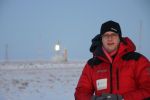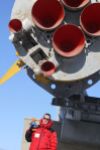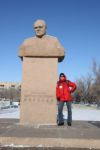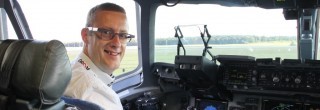 After the great success of the first European #SpaceTweetup, a bunch of European spacetweeps, led by DLR social media editor @HenningKrause, decided to start the new year with a new tweetup. More a networking event than a tweetup, it became the sequel to #SpaceKoelsch. Last September this was the pre-party to the ESA/DLR #Spacetweetup. Now the event in a typical Cologne beerhall became the main event itself. #SpaceKoelsch 2 was born! Continue reading
After the great success of the first European #SpaceTweetup, a bunch of European spacetweeps, led by DLR social media editor @HenningKrause, decided to start the new year with a new tweetup. More a networking event than a tweetup, it became the sequel to #SpaceKoelsch. Last September this was the pre-party to the ESA/DLR #Spacetweetup. Now the event in a typical Cologne beerhall became the main event itself. #SpaceKoelsch 2 was born! Continue reading
Ruimtevaart
Als directeur van World Space Week kom ik op bijzondere plaatsen en ontmoet ik bijzondere mensen in de ruimtevaart. In dit blog vertel ik over mijn omzwervingen in deze bijzondere wereld. x
Space 2.0
 Triggered by the Space 2.0 LinkedIn group I wrote this blog post, investigating what 2.0 means in space exploration. It is interesting to see the 2.0-hype spread over all aspects of society these days. It is being used for anything slightly futuristic, regardless whether it is really something new. And with the widespread of the term 2.0, newer developments are now slated 3.0 or even higher. So what is ‘Space 2.0′ really? Continue reading
Triggered by the Space 2.0 LinkedIn group I wrote this blog post, investigating what 2.0 means in space exploration. It is interesting to see the 2.0-hype spread over all aspects of society these days. It is being used for anything slightly futuristic, regardless whether it is really something new. And with the widespread of the term 2.0, newer developments are now slated 3.0 or even higher. So what is ‘Space 2.0′ really? Continue reading
2011: Mijn top-5 van een historisch ruimtevaartjaar
 Een typisch oudejaarsblog, zo op de laatste dag van het jaar. Nog even terugkijken voordat we met goede moed aan een nieuw jaar beginnen. Voor mij was 2011 het jaar van de herontdekking van mijn ruimtevaartpassie. Als kleine jongen was ik gefascineerd door de ruimtevaart. De lancering van de eerste Space Shuttle in 1981 was het hoogtepunt van deze periode en ook de SpaceLab missie van Wubbo Ockels in 1985 staat me nog duidelijk voor ogen. Daarna werd ik zo afgeleid door dingen als puberteit, studiekeuze, carrière en gezin, dat de ruimtevaart naar de achtergrond verdween.
Een typisch oudejaarsblog, zo op de laatste dag van het jaar. Nog even terugkijken voordat we met goede moed aan een nieuw jaar beginnen. Voor mij was 2011 het jaar van de herontdekking van mijn ruimtevaartpassie. Als kleine jongen was ik gefascineerd door de ruimtevaart. De lancering van de eerste Space Shuttle in 1981 was het hoogtepunt van deze periode en ook de SpaceLab missie van Wubbo Ockels in 1985 staat me nog duidelijk voor ogen. Daarna werd ik zo afgeleid door dingen als puberteit, studiekeuze, carrière en gezin, dat de ruimtevaart naar de achtergrond verdween.
Baikonur blog – launch day!
More launch pads, SoyuzTweetup and a Launch!
 Baikonur, 21 December 2011 – Finally. Today is the day we have been living up to for a long time. The launch of Soyuz TMA-03M, with ‘the’ Dutch astronaut André Kuipers on board. It is still dark outside when I wake up around 8 o’clock. Today our program consists of two major visits. First we will go to the furthest launch location at the cosmodrome: the Proton launch facility. Then we have some time in the city before going to launch pad 1 for the launch in the early evening.
Baikonur, 21 December 2011 – Finally. Today is the day we have been living up to for a long time. The launch of Soyuz TMA-03M, with ‘the’ Dutch astronaut André Kuipers on board. It is still dark outside when I wake up around 8 o’clock. Today our program consists of two major visits. First we will go to the furthest launch location at the cosmodrome: the Proton launch facility. Then we have some time in the city before going to launch pad 1 for the launch in the early evening.
Baikonur blog – space history and more space history
Launch Pads, Shuttles and Public Outreach
 Baikonur, 20 December 2011 – After breakfast at our hotel we are greeted again by our guide Elena and driver Said. The uncomfortable van is heated up and waiting for us, this time with the Tsenki security lady already inside. When we leave she hands us two “cosmodrome rules” forms and asks us to sign a list with our names on it. No idea why this was not needed yesterday, but we happily comply. We are waved past the city exit checkpoint, and easily pass the cosmodrome entrance checkpoint. Then again a long empty road to the cosmodrome facilities. This time we go straight on, towards the far end of this middle section at site 250. This launch pad is no longer active, but of great historical importance, as it was built for the Russian space shuttle Buran in the 1980’s.
Baikonur, 20 December 2011 – After breakfast at our hotel we are greeted again by our guide Elena and driver Said. The uncomfortable van is heated up and waiting for us, this time with the Tsenki security lady already inside. When we leave she hands us two “cosmodrome rules” forms and asks us to sign a list with our names on it. No idea why this was not needed yesterday, but we happily comply. We are waved past the city exit checkpoint, and easily pass the cosmodrome entrance checkpoint. Then again a long empty road to the cosmodrome facilities. This time we go straight on, towards the far end of this middle section at site 250. This launch pad is no longer active, but of great historical importance, as it was built for the Russian space shuttle Buran in the 1980’s.
Continue reading
Baikonur blog – A Soviet city
A week in one day
 Baikonur, 19 December 2011 – At the moment I write this I have spent 28 hours in Baikonur. That is 26 more than when I wrote my blog yesterday. But it feels like more, way more. A day with a full schedule and weird coincidences, which can turn an ordinary trip into a great adventure! It definitely turned these 26 hours into an experience that feels like a week. It started with the alarm clock at 7:30 this morning… Continue reading
Baikonur, 19 December 2011 – At the moment I write this I have spent 28 hours in Baikonur. That is 26 more than when I wrote my blog yesterday. But it feels like more, way more. A day with a full schedule and weird coincidences, which can turn an ordinary trip into a great adventure! It definitely turned these 26 hours into an experience that feels like a week. It started with the alarm clock at 7:30 this morning… Continue reading
Baikonur blog – getting to Baikonur
A late night arrival in Baikonur
 Baikonur, 18 December 2011 – I write this blog on my first evening in Baikonur. Actually, I crossed the border checkpoint from Kazakhstan less than two hours before writing this. So far I have experienced Baikonur city as dark, remote and extremely cold. When our local guide Elena Sadykova picked us up at the Tyuratam railway station, she herself said that at -25°C even the locals consider it very cold. Continue reading
Baikonur, 18 December 2011 – I write this blog on my first evening in Baikonur. Actually, I crossed the border checkpoint from Kazakhstan less than two hours before writing this. So far I have experienced Baikonur city as dark, remote and extremely cold. When our local guide Elena Sadykova picked us up at the Tyuratam railway station, she herself said that at -25°C even the locals consider it very cold. Continue reading
Een lancering vanaf 7000 kilometer
 Gisteren werd ik onverwacht uitgenodigd voor het meemaken van een Europese lancering. Op 9 september a.s. zal een Ariane 5 raket twee satellieten in een baan om de aarde brengen. Europese lanceringen gebeuren vanuit het Arianespace ruimtecentrum in Kourou, Frans Guyana. Maar een groot deel van de lancering en de vlucht controle vinden plaats vanuit Europa, in het Lanceringscentrum van de Franse Ruimtevaartorganisatie CNES in Evry. Continue reading
Gisteren werd ik onverwacht uitgenodigd voor het meemaken van een Europese lancering. Op 9 september a.s. zal een Ariane 5 raket twee satellieten in een baan om de aarde brengen. Europese lanceringen gebeuren vanuit het Arianespace ruimtecentrum in Kourou, Frans Guyana. Maar een groot deel van de lancering en de vlucht controle vinden plaats vanuit Europa, in het Lanceringscentrum van de Franse Ruimtevaartorganisatie CNES in Evry. Continue reading
De toekomst van de bemande ruimtevaart
 De lancering van Space Shuttle Atlantis STS-135 markeert het voorlopige einde van de Amerikaanse bemande ruimtevaart. NASA heeft geen operationele opvolger en zijn voorlopig afhankelijk van het Russische Soyuz programma om mensen van en naar het ISS te sturen. Op 30 september 2011 wordt NASA astronaut Daniel Burbank de eerste post-shuttle astronaut die met een Soyuz TMA capsule vanuit Baikonur wordt gelanceerd. Continue reading
De lancering van Space Shuttle Atlantis STS-135 markeert het voorlopige einde van de Amerikaanse bemande ruimtevaart. NASA heeft geen operationele opvolger en zijn voorlopig afhankelijk van het Russische Soyuz programma om mensen van en naar het ISS te sturen. Op 30 september 2011 wordt NASA astronaut Daniel Burbank de eerste post-shuttle astronaut die met een Soyuz TMA capsule vanuit Baikonur wordt gelanceerd. Continue reading
Alleen voor echte spacegeeks: de SRB Retrieval
 Na twee dagen te gast te zijn geweest bij de NASA is het moeilijk om afscheid te nemen van alles en iedereen bij Kennedy Space Center. Gelukkig is er nog een laatste mogelijkheid elkaar te ontmoeten bij een onderdeel van de lancering: Twee dagen na de lift-off komen namelijk de SRB’s (Solid Rocket Boosters) terug op Cape Canaveral. Continue reading
Na twee dagen te gast te zijn geweest bij de NASA is het moeilijk om afscheid te nemen van alles en iedereen bij Kennedy Space Center. Gelukkig is er nog een laatste mogelijkheid elkaar te ontmoeten bij een onderdeel van de lancering: Twee dagen na de lift-off komen namelijk de SRB’s (Solid Rocket Boosters) terug op Cape Canaveral. Continue reading
